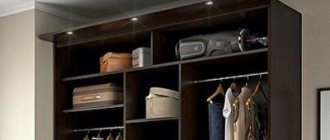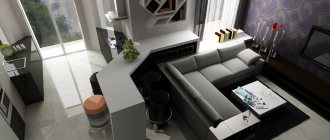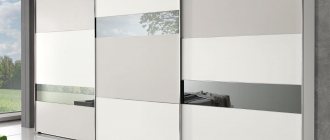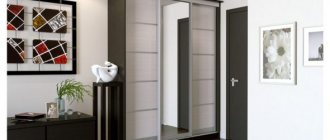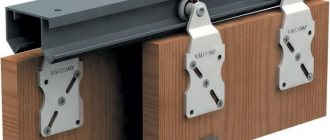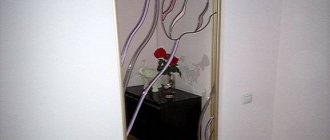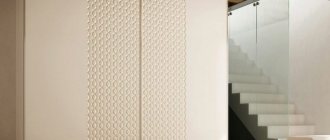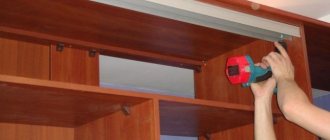The design of guides for sliding sliding doors includes various components and parts, the main function of which is to ensure the movement of various elements of furniture structures. For example, they ensure free (without jamming) sliding of the doors of various types of cabinets.
Today, two systems of guide mechanisms are most common:
- door, which include several design varieties;
- for extending box structures - table drawers, sofa trays, tabletop extensions and shelving.
Of greatest interest are systems for sliding interior sliding doors and sliding wardrobe doors.
Main functional purpose
Various types of sliding door guides must ensure the free closing and opening of sliding doors, regardless of whether they are interior doors or cabinet doors. The basis of any design is the rails along which the doors move horizontally using rollers.
Additional accessories include:
- roller hangers or supports;
- profile seals and plugs;
- clamps;
- small fittings;
- additional devices, the availability of which depends on the specific choice of rollers and guides.
The choice of guide profile depends on the overall dimensions of the furniture parts, the weight of the sashes, their number and other factors. It is not difficult to purchase all the necessary components and fittings for furniture today; just look at the price list of any furniture supermarket. On the modern furniture market there are budget options:
- "SLIDER-Volkhovets",
- "Framir"
- "Herkules" or "Rollan".
So are imported ones, the price of which is quite high:
- "Raumplus"
- "Francco"
- "Archie"
- "Hangroller"
Guides
When choosing a profile for sliding doors, regardless of the type of sliding system, the main attention is paid to the material of its manufacture. Today they are made from various materials.
The plastic guide profile has the lowest cost, but has a significant drawback - relatively poor reliability and short service life. Today, combined rail supports are mainly used, in which a plastic profile has a metal supporting surface for the rollers.
Steel rail supports are highly reliable. Their price is low and depends primarily on the brand. Moreover, sometimes the cost is clearly too high compared to the performance properties and ease of installation.
Rail supports of all well-known furniture brands are made from aluminum, including circular guides for sliding doors. They have the best technical characteristics and high ergonomic and aesthetic properties. Thanks to their optimized properties, they can be used to install sliding panels of any weight and width, up to five meters in height. The only drawback is the significant cost.
Depending on the type of hanging option and the number of sashes, rail guides can be one-, two- or three-lane. In addition, the supports themselves are made straight or curved.
To increase decorativeness and aesthetics, almost all elements and parts are anodized, chrome-plated or painted using powder coating technology. The type of tinting can be anything, from traditional silver, gold or wood texture, and up to “antique bronze”.
Manufacturing materials
The noiselessness and softness of the sash movement depend on the material used to make the rollers:
- Rubber is an elastic product; an element made from this raw material does not create noise when moving. But such products wear out quickly, and therefore have a short service life.
- Plastic is a budget item that requires careful use. Such fittings are vulnerable to impacts and wear out quickly. During use, chips and dents are possible.
- Steel is a durable material. The rollers must have soft linings that ensure quiet gliding. They can withstand heavy loads, which allows them to be used in large cabinets.
- Teflon is the optimal ratio of cost and quality. Serves as protection for metal rollers and ensures silent sliding along the guides. Guarantees long-term operation.
- Tarmonide is a hardened composite, wear-resistant, with a large margin of safety.
The service life of the fittings depends not only on the material, but also on the correct installation and adjustment of the rollers for sliding wardrobes.
Plastic
Rubber
Steel
Teflon
Types of sliding systems
In residential premises, sliding doors with an upper or lower swing type are most widespread.
Top-hung means hanging doors on a guide installed in the upper part of the opening. The support rollers roll over the top. The lower guide is fixing and the fixing rollers move along it.
Thanks to this, transverse vibrations of the hung canvas are eliminated. The undoubted advantage of this mechanism is the integrity of the floor covering, it is more aesthetically pleasing and easier to open. If the lower profile is installed below the floor level, a threshold-free structure is obtained, and the locking rollers of the sliding doors will move along a hidden guide.
The lower one has a similar design, but the supporting element is the lower, fixed profile. The top rail and rollers prevent the sashes from falling out.
Combined systems, in which the sashes are supported and fixed along the upper and lower profiles, are more reliable. However, they are more difficult to install and adjust.
The first option is mainly used when arranging sliding partitions and creating interior sliding doors that move along the wall. The second and third are predominantly used in wardrobes.
Most commercially available kits are classified according to their load capacity, which depends on the total weight of the door leaves. In addition, when selling any kit, a supermarket salesperson or online store manager will definitely ask the client about the type of system (suspended or support) and the preferred price range.
A video clearly showing the types of guides and their attachment points.
Buffer tape
Glue the seal after adjusting the door leaves, as it will close all the holes that provide access to their adjustment. Sliding mechanisms for interior doors, sliding door guides. Buffer tape is available with short (up to 6 mm) and long (up to 12 mm) pile. Its color matches the color of the sliding system, and it is very easy to glue. To do this, the protective film is removed from the back side and the tape is applied to the end of the door.
Now the work on installing sliding doors in the wardrobe can be considered complete. For sliding doors, rollers and guides for sliding doors. With my own hands. All that remains is to remove the film from the profile and wipe the glass or mirrors with window cleaning liquid. And you can safely fill the interior space with your things!
Installation
The process of installing sliding doors is simple and consists of assembling all the components, parts and fittings included in the purchased kit. In this case, the apartment owner himself decides whether he will order sliding panels separately or purchase them together with a set. Any person with minimal plumbing skills will be able to perform the installation work independently. However, the assembly process itself requires special care and precision. The first step in installing any horizontally sliding panels is to install and secure the support profiles.
The reliability of the operation of sliding doors and the ease of their operation depend on the qualified and careful installation of the guides. This applies to both top and bottom rail systems and longitudinal opening types. In case of poor installation, the possibility of the sash coming off cannot be ruled out. Of course, such a situation will not lead to tragic consequences, but the work to restore the functionality of the doors is quite labor-intensive.
The simplest option is installation with a single-strip support rail.
This option is used for installing single-leaf interior doors or double-leaf ones, when the leaves are installed without overlap, but end-to-end and slide apart in opposite directions. Let's look at the fastening process using their example.
The assembly of any sliding system begins with fastening the upper support profile. Typically, this operation does not cause problems. For installation, in most cases it is necessary to attach an additional beam to the wall, above the doorway. For a single-leaf door, its minimum length should be equal to double the width of the opening. If double-leaf interior doors are installed in a living space, then the length of the beam should be equal to four times the width of the opening.
After fixing the upper profile, pre-assembled sashes are hung on it. For most industrially manufactured kits, this operation is performed by simply “winding” the door rollers through the end of the support profile.
The hung canvas is aligned vertically, using a level or laser plumb line. Next, you need to secure the bottom guide to the floor. Its installation and fastening depends on the sliding door system (hung or supported), the type of rollers and the nuances of the purchased kit. Usually, at the first stage of installing the lower or fixing profile, it is not rigidly fastened. Having secured it “live”, they check the functionality of the entire structure and only after making sure that the assembly is correct and the panels slide freely, they finally fix it.
Often the fastening of both parts is carried out before installing the rollers on the canvas. The sequence of work is similar to that described above. The alignment of the rail in the vertical plane is controlled using a building level, and the distance between their surfaces is controlled with a regular tape measure. After installing the support profiles, the door leaves are assembled, which are then hung in the usual way.
The video clearly shows the process of installation and installation of sliding wardrobe doors.
Of course, there are other assembly schemes. Some “craftsmen” generally refuse to purchase a full set, purchasing only videos. At the same time, there are more options for creativity, both in the choice of panels themselves and fastening parts.
Required Tools
Before assembling the cabinet doors and installing the guides, you should prepare a number of tools. Among them:
- Metal ruler, square and tape measure.
- Drill-driver.
- Electric jigsaw.
- Hacksaw for metal processing.
- Driver for self-tapping screws.
- Construction level and plumb line.
- Cutter and scissors.
Features of installation of “pure” hinged sliding doors
Today, in the online trading system and in furniture supermarkets, you can purchase kits for installing sliding doors without a bottom guide. A typical representative is the Raumplus kits.
Preventing vibrations of hanging sliding doors is carried out due to the special design of the upper roller support and the weight of the door leaf. The roller support has a rather complex mechanism. Typically a roller carriage contains four rollers. The advantages of “Raumplus” type structures include ease of installation. The home craftsman should only securely fasten the top profile and install the panels.
However, support-free suspension systems require more careful maintenance and handling. An alternative to these are bottom support wheel designs, which do not require a bottom support rail. In this case, the door leaves have special wheels at the bottom that roll freely directly on the floor surface. As a rule, the lower wheels are spring-loaded, which to a certain extent compensates for uneven floors.
Undoubtedly, the optimal solution for installing sliding interior doors is to contact specialized companies that sell roller kits and install them on a turnkey basis. Most of them offer customers several options when placing an order, differing in both systems and final design. However, many homeowners, after considering various options, opt for self-installation. It is not uncommon for home craftsmen to completely refuse to purchase ready-made kits, purchasing separate panels, separate upper and lower profiles, and ordering roller supports individually.
Gallery of furniture with sliding doors
Various sliding wardrobes allow you not only to save living space, but are also a great way to diversify the interior of a bedroom or hallway.
